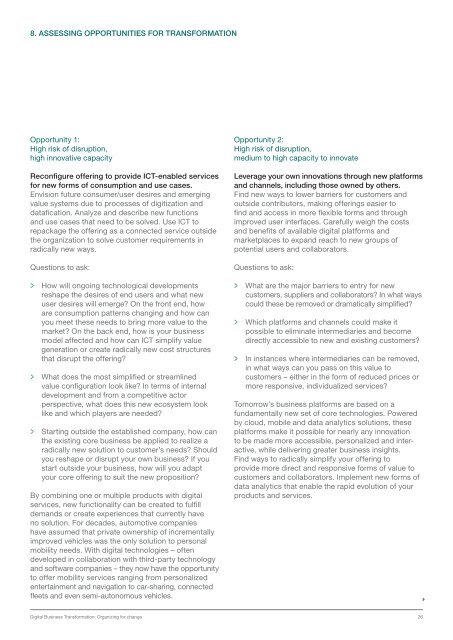ORGANIZING FOR CHANGE
UhUqd
UhUqd
You also want an ePaper? Increase the reach of your titles
YUMPU automatically turns print PDFs into web optimized ePapers that Google loves.
8. ASSESSING OPPORTUNITIES <strong>FOR</strong> TRANS<strong>FOR</strong>MATION<br />
Opportunity 1:<br />
High risk of disruption,<br />
high innovative capacity<br />
Reconfigure offering to provide ICT-enabled services<br />
for new forms of consumption and use cases.<br />
Envision future consumer/user desires and emerging<br />
value systems due to processes of digitization and<br />
datafication. Analyze and describe new functions<br />
and use cases that need to be solved. Use ICT to<br />
repackage the offering as a connected service outside<br />
the organization to solve customer requirements in<br />
radically new ways.<br />
Questions to ask:<br />
> How will ongoing technological developments<br />
reshape the desires of end users and what new<br />
user desires will emerge? On the front end, how<br />
are consumption patterns changing and how can<br />
you meet these needs to bring more value to the<br />
market? On the back end, how is your business<br />
model affected and how can ICT simplify value<br />
generation or create radically new cost structures<br />
that disrupt the offering?<br />
> What does the most simplified or streamlined<br />
value configuration look like? In terms of internal<br />
development and from a competitive actor<br />
perspective, what does this new ecosystem look<br />
like and which players are needed?<br />
> Starting outside the established company, how can<br />
the existing core business be applied to realize a<br />
radically new solution to customer’s needs? Should<br />
you reshape or disrupt your own business? If you<br />
start outside your business, how will you adapt<br />
your core offering to suit the new proposition?<br />
By combining one or multiple products with digital<br />
services, new functionality can be created to fulfill<br />
demands or create experiences that currently have<br />
no solution. For decades, automotive companies<br />
have assumed that private ownership of incrementally<br />
improved vehicles was the only solution to personal<br />
mobility needs. With digital technologies – often<br />
developed in collaboration with third-party technology<br />
and software companies – they now have the opportunity<br />
to offer mobility services ranging from personalized<br />
entertainment and navigation to car-sharing, connected<br />
fleets and even semi-autonomous vehicles.<br />
Opportunity 2:<br />
High risk of disruption,<br />
medium to high capacity to innovate<br />
Leverage your own innovations through new platforms<br />
and channels, including those owned by others.<br />
Find new ways to lower barriers for customers and<br />
outside contributors, making offerings easier to<br />
find and access in more flexible forms and through<br />
improved user interfaces. Carefully weigh the costs<br />
and benefits of available digital platforms and<br />
marketplaces to expand reach to new groups of<br />
potential users and collaborators.<br />
Questions to ask:<br />
> What are the major barriers to entry for new<br />
customers, suppliers and collaborators? In what ways<br />
could these be removed or dramatically simplified?<br />
> Which platforms and channels could make it<br />
possible to eliminate intermediaries and become<br />
directly accessible to new and existing customers?<br />
> In instances where intermediaries can be removed,<br />
in what ways can you pass on this value to<br />
customers – either in the form of reduced prices or<br />
more responsive, individualized services?<br />
Tomorrow’s business platforms are based on a<br />
fundamentally new set of core technologies. Powered<br />
by cloud, mobile and data analytics solutions, these<br />
platforms make it possible for nearly any innovation<br />
to be made more accessible, personalized and interactive,<br />
while delivering greater business insights.<br />
Find ways to radically simplify your offering to<br />
provide more direct and responsive forms of value to<br />
customers and collaborators. Implement new forms of<br />
data analytics that enable the rapid evolution of your<br />
products and services.<br />
Digital Business Transformation: Organizing for change 26


